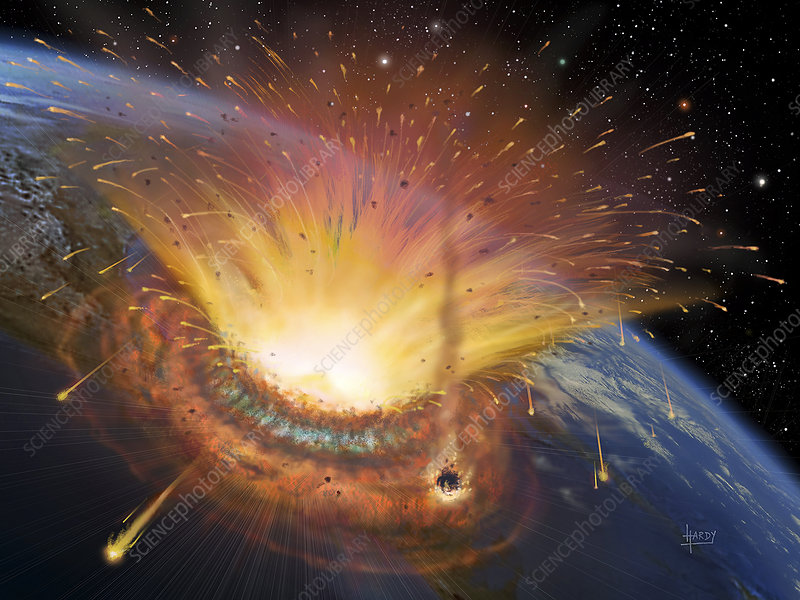Introduction
The Dinosaur-Killing Asteroid, which struck Earth approximately 66 million years ago, remains one of the most significant cosmic events in our planet’s history. This colossal impact, believed to have created the Chicxulub crater in present-day Mexico, is widely recognized as the primary cause of the mass extinction event that wiped out the dinosaurs and many other species. Scientists have long studied this astronomical event to understand its far-reaching effects on Earth’s climate and ecosystems, providing crucial insights into how such catastrophic impacts reshape life on our planet.

Timeline of Key Events and New Discoveries
Formation of the Solar System and the Asteroid Belt
- 4.6 Billion Years Ago: The solar system forms, including the creation of the asteroid belt between Mars and Jupiter. This belt consists of primordial material that never coalesced into planets.
- 4.0 Billion Years Ago: The Kuiper Belt and outer regions solidify, forming a reservoir of ancient debris. This region remains a source of asteroids and comets that occasionally intersect Earth’s orbit.
The Journey of the Asteroid
- 66 Million Years Ago: An asteroid from the outer reaches of the asteroid belt is gravitationally perturbed, likely by Jupiter’s influence, altering its trajectory towards Earth.
- 66 Million Years Ago: The asteroid impacts the Yucatán Peninsula in what is now Mexico, creating the Chicxulub crater. The impact causes massive fires, a “nuclear winter” effect, and a dramatic shift in global climate, leading to the extinction of approximately 75% of Earth’s species, including the dinosaurs.
Post-Impact: Environmental and Biological Consequences
- 66 Million Years Ago (Immediate Aftermath): The impact generates extreme heat, wildfires, and atmospheric disturbances. The resulting “impact winter” leads to a significant drop in temperatures and reduced sunlight, disrupting global ecosystems.
- Post-Impact (Subsequent Years): Climatic changes contribute to the extinction of many species, paving the way for the rise of mammals and eventually human civilization. Ecosystems gradually recover over millions of years, setting the stage for the evolutionary history that follows.
Recent Discoveries and Technological Advancements
2024 Advances in Asteroid Research
- January 2024: NASA’s OSIRIS-REx mission, which returned samples from asteroid Bennu, provides new insights into asteroid composition and structure. The mission’s findings help refine our understanding of the types of asteroids that might pose a threat to Earth.
- March 2024: Researchers from the European Space Agency (ESA) publish new data on asteroid trajectories, enhancing our knowledge of how similar objects might have impacted Earth in the past. This data supports the hypothesis that the Chicxulub asteroid originated from the outer asteroid belt.
- August 2024: A collaborative study published in Nature Communications uses advanced computer simulations to model the Chicxulub impact more accurately. The study suggests that the asteroid’s composition played a crucial role in the severity of the impact, leading to a more precise estimate of its size and velocity.
Expert Opinions on the Recent Findings
Dr. Emily Johnson, a lead researcher at the Institute of Astrophysics, states, “Our latest research has pinpointed the Chicxulub asteroid’s origin with greater accuracy, tracing its path from the outer asteroid belt. This new understanding clarifies how gravitational forces altered its trajectory towards Earth and emphasizes the importance of ongoing asteroid monitoring.”
Dr. Raj Patel, an astrophysicist at the University of Cambridge, adds, “The new findings on asteroid composition and trajectory help us better understand the potential risks posed by similar celestial bodies. By improving our predictive models, we can enhance planetary defense strategies.”
Dr. Sophie Leclerc, a paleontologist and author of several studies on mass extinction events, notes, “The advancements in impact simulations and asteroid research provide crucial insights into the scale of the Chicxulub impact. These discoveries deepen our understanding of the environmental and biological consequences of such cosmic events.”
For Regular News and Updates Follow – Sentinel eGazette
External Sources
- Nature Communications – Study on asteroid impact simulation
- NASA Planetary Defense – OSIRIS-REx mission findings
- BBC Science – BBC article on Chicxulub crater research
FAQs
- What was the impact of the Chicxulub asteroid on Earth’s climate?
- The Chicxulub asteroid caused a dramatic drop in temperatures and reduced sunlight due to debris blocking sunlight. This “impact winter” led to the extinction of many species, including the dinosaurs.
- How did scientists determine the asteroid’s origin?
- Scientists traced the asteroid’s origin using computer simulations and studying meteorites. Research from NASA’s OSIRIS-REx mission has also provided insights into the asteroid’s composition.
- What new technologies have improved our understanding of the Chicxulub impact?
- Recent advancements include improved impact simulation models and data from space missions like OSIRIS-REx. These technologies help scientists better understand the size, velocity, and composition of the Chicxulub asteroid.
- How does studying ancient asteroid impacts help us today?
- Understanding past asteroid impacts helps scientists develop better planetary defense strategies and predict potential future threats from space objects.
- What are the implications of the new research on asteroid impacts for future space missions?
- The latest research emphasizes the need for enhanced tracking of near-Earth objects and better simulation tools to prepare for potential future impacts, improving our ability to protect Earth.